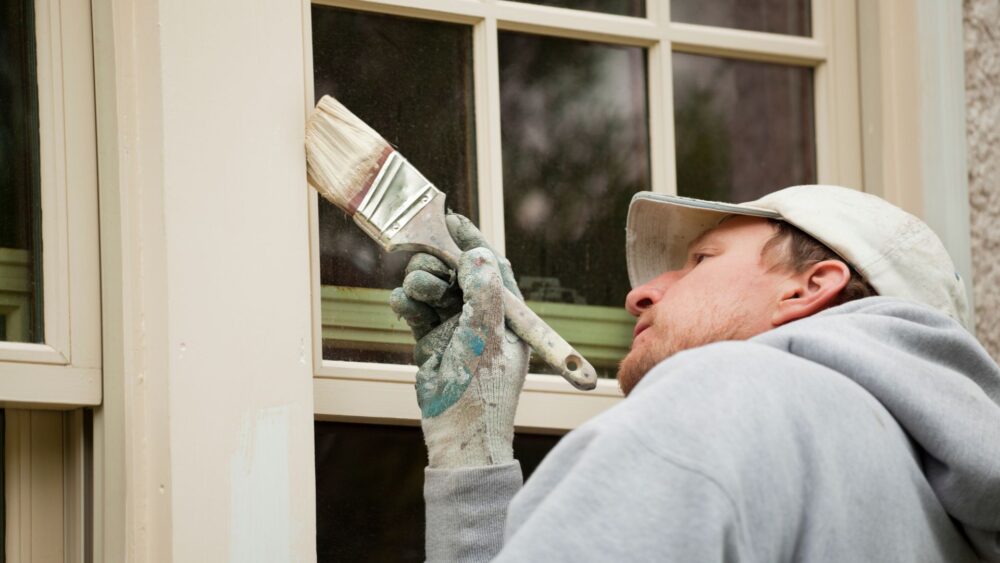When it comes to maintaining the exterior of your home, siding care is often overlooked until it becomes a glaring issue. But did you know that with just a little bit of effort, you could keep your siding looking like new? Forget about having to hire someone or spending days trying to figure out the best approach. I’m going to tell you how you can make your siding care so easy; even if you’re not paying attention, it’ll still look good.
Cleaning Different Types of Siding
Keeping your home’s siding clean is key to maintaining its curb appeal. But not all siding is created equal when it comes to cleaning.
Every material dances to its own beat, so it’s clear we need a unique strategy for each one. Let’s break it down by type.
Cleaning Vinyl Siding
Vinyl siding is one of the most common and low-maintenance options out there. To clean it:
- Divide your siding into 10-foot sections.
- Scrub each section using a soft-bristled brush attached to a long handle.
- Work from bottom to top to avoid streaking and rinse often.
- For two-story homes, you’ll be using a ladder, so keep safety foremost.
A simple mix of dish soap and warm water usually does the trick for vinyl.
Cleaning Natural Wood Siding
Wood siding offers unbeatable beauty and insulation. But it takes some elbow grease to maintain.
Of all the types of siding, wood requires the most upkeep. Regular cleaning with a soft brush and soapy water is a must to prevent rot and decay.
Cleaning Fiber Cement Siding
Fiber cement is a durable, low-maintenance option that’s growing in popularity. To clean it, use a soft cloth or brush with a mild detergent and water.
Avoid using a pressure washer, as it can damage the surface. Stick to hand-washing for the best results.
Cleaning Stucco Siding
Stucco is a classic choice that adds texture and character to any home. To keep it looking its best:
- Use a garden hose to remove loose dirt and debris.
- For tougher stains, scrub with a soft bristle brush and a mixture of water and mild detergent.
- Rinse thoroughly from top to bottom.
Avoid using a pressure washer on stucco, as it can cause chipping and cracking.
Siding Maintenance Tips for Homeowners
Cleaning your siding is just one part of the maintenance equation. To keep your home’s exterior in tip-top shape, make these tasks part of your regular routine.
Regular Cleaning and Washing
Aim to clean your siding at least once a year, or more often if you live in a humid climate. This will prevent dirt, grime, and mildew from building up and keep your home looking its best.
Inspecting for Damage
While you’re cleaning, take the opportunity to inspect your siding for any signs of damage. Keep an eye out for any cracks, holes, or pieces that might be coming loose and could use a bit of fixing up.
Catching small issues early can save you from costly repairs down the line.
Addressing Minor Repairs
If you do spot any minor damage, address it right away. Small holes or cracks can usually be filled with caulk or patching compound.
For loose siding, simply reattach it with nails or screws. With these simple tricks up your sleeve, you can make sure your siding stays in tip-top shape for a lot longer.
Trimming Vegetation Near Siding
Keep trees, shrubs, and other vegetation trimmed back from your siding. Overhanging branches can scratch and damage the surface, while plants that touch the siding can trap moisture and lead to rot.
Sealing and Caulking
Inspect the caulking and sealant around windows, doors, and other openings in your siding. If you see any cracks or gaps, reseal them to prevent water infiltration.
This is especially important before the rainy or snowy season hits.
Removing Tough Stains and Mildew from Siding
Sometimes, regular cleaning isn’t enough to tackle tough stains or mildew growth on your siding. When that happens, it’s time to bring in the big guns.
Using a Pressure Washer
A pressure washer can be a powerful tool for blasting away stubborn dirt and grime. But it’s important to use it correctly to avoid damaging your siding.
Start with the lowest pressure setting and work your way up until you find the right balance. Keep the nozzle at least 12 inches away from the surface and use a wide spray pattern.
Cleaning Without a Pressure Washer
If you don’t have a pressure washer, you can still tackle tough stains with a little elbow grease. Mix up a solution of warm, soapy water and apply it to the stains with a soft-bristled brush.
For mildew, add a cup of bleach to your mixture. Let the solution sit for a few minutes before scrubbing and rinsing thoroughly.
Choosing the Best Vinyl Siding Cleaner
If you have vinyl siding, there are specialty cleaners available that can make the job easier. Look for a product that’s specifically designed for use on vinyl.
Avoid using harsh chemicals or abrasive scrubbers, as these can damage the surface. A soft cloth or sponge is usually all you need.
Preventing Mildew Growth
Mildew thrives in damp, shady areas. To prevent it from growing on your siding, make sure your home has proper drainage and ventilation.
Keep gutters clean and direct downspouts away from the foundation. Trim back trees and shrubs to allow sunlight and air to reach the siding.
Maintaining Your Siding’s Appearance
Even with regular cleaning and maintenance, your siding may start to show its age over time. So, let’s dive into some handy tips that’ll help you keep everything looking spotless and brand-spanking new.
Painting and Staining Siding
If your siding is looking faded or worn, a fresh coat of paint or stain can work wonders. This is a job best left to the professionals, as it requires proper preparation and technique.
Choose a color that complements your home’s style and surroundings. Don’t be afraid to try something new – a bold color can really make your home stand out.
Dealing with Stains and Discoloration
Despite your best efforts, stains and discoloration can still happen. Rust, dirt, and environmental pollutants can all leave their mark on your siding.
For minor stains, try cleaning with a mixture of vinegar and water. For tougher stains, you may need to use a commercial cleaner or even sand the area before repainting.
Handling Dents in Aluminum Siding
Aluminum siding doesn’t play well with hail or other sudden hits, easily getting dinged up in the process. Small dents can often be popped out from the inside using a block of wood and a rubber mallet.
For larger dents, you may need to replace the damaged panel entirely. This is a job best left to a professional siding contractor.
Restoring Wood’s Natural Color
Wood siding can fade and turn gray over time due to exposure to the elements. To restore its natural color, you’ll need to clean it thoroughly and apply a fresh coat of stain or sealant.
Look for products that offer UV protection to help prevent future fading. Regular maintenance will keep your wood siding looking beautiful for years to come.
When to Call a Professional for Siding Repairs
While many siding maintenance tasks can be DIY-ed, some repairs are best left to the professionals. Here are some signs that it’s time to call in a pro.
Identifying Significant Damage
If you notice large cracks, holes, or missing pieces of siding, it’s time to call a contractor. If you let these issues slide, water might sneak into your home’s structure, causing rot and a whole bunch of other damage.
A professional can assess the extent of the damage and recommend the best course of action.
Replacing Damaged Siding
If your siding is beyond repair, it may need to be replaced entirely. This is a big job that requires specialized tools and expertise.
A siding contractor can help you choose the best material for your home and budget, and ensure that it’s installed correctly for maximum durability.
Repairing Cracks and Gaps in Stucco
Stucco is prone to cracking and chipping over time. While small cracks can often be filled with caulk, larger cracks may require professional repair.
A stucco contractor can assess the damage and determine the best method for repair, whether it’s patching, resurfacing, or replacing the affected area.
FAQs in Relation to Siding Care
How do you maintain siding?
Keep it clean with regular washes. Check for damage often and fix small issues promptly. Trim nearby plants to avoid scratches.
What should not be used on vinyl siding?
Avoid using bleach or harsh chemicals directly. Steer clear of abrasive scrubbers that can scratch the surface.
How do I protect my house siding?
Clean it yearly, inspect regularly for any damages, and make quick repairs as needed. Also, apply a fresh coat of paint or sealant when required.
What is the best thing to clean siding?
A mix of water and mild dish soap works wonders. For tougher stains, use a specialized cleaner designed for your type of siding.
Conclusion
If there’s one thing we’ve learned today, it’s that taking care of your siding doesn’t have to be complicated. From choosing the right materials for repairs to cleaning without causing damage, simple steps can ensure lasting beauty for years ahead.
Your efforts will pay off in more ways than one – saving money over time by avoiding costly repairs and increasing curb appeal should come naturally as long as consistency is maintained.
Siding might seem minor but think again – It plays a crucial role in protecting against harsh weather while making our homes look their absolute best.
Find & Book Estimates With Top Local Contractors
Go to costguide.com to compare local siding pros near you!




